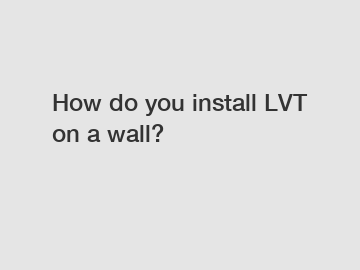How do you install LVT on a wall?
How do you install LVT on a wall?
LVT, also known as Luxury Vinyl Tile, is an increasingly popular choice for flooring due to its durability, versatility, and aesthetic appeal. However, have you ever considered using LVT on your walls? Installing LVT on a wall can add a striking visual element to any space, creating a modern and unique accent. In this article, we will explore how you can install LVT on a wall and discuss the various benefits and considerations associated with this innovative application.
1. Preparation:

Before installing LVT on a wall, proper preparation is crucial. Ensure that the wall surface is clean, flat, and free from any debris or imperfections. Use a level to check for any unevenness, as this can affect the final result. Additionally, consider applying a primer to the wall to enhance the adhesion of the LVT.
2. Choosing the right adhesive:
Selecting an appropriate adhesive is essential when installing LVT on a wall. Look for an adhesive specifically designed for wall applications, as it needs to provide a strong bond while allowing for some flexibility. Consult with a professional or refer to the manufacturer's guidelines to identify the most suitable adhesive for your specific LVT product.
3. Measuring and cutting the LVT:
Measure the dimensions of the wall area where you intend to install the LVT. It is crucial to calculate the required amount of LVT accurately to avoid any excess or shortage. Once measured, use a utility knife or a vinyl cutter to cut the LVT to the desired size and shape. Take your time to ensure precise cuts, especially when dealing with corners or irregularities in the wall.
4. Applying the adhesive:
Following the manufacturer's instructions, apply the chosen adhesive to the backside of the LVT using a notched trowel or a recommended applicator. Start by applying a thin and even layer across the entire surface. Ensure complete coverage while avoiding excessive adhesive, as this can lead to difficulties in aligning the LVT during installation.
5. Installing the LVT:
Begin by carefully aligning the first piece of LVT with the bottom of the wall. Apply gentle pressure to ensure proper contact with the adhesive. Continue installing subsequent pieces, making sure to butt the edges tightly together for a seamless appearance. Use a roller to eliminate any air bubbles and ensure a firm bond between the LVT and the wall.
6. Dealing with obstacles:
When installing LVT on a wall, you may encounter obstacles such as electrical outlets, switches, or windows. To work around these obstacles, mark the shape and size of the obstruction on the backside of the LVT using a template. Cut the LVT accordingly, ensuring a precise fit. Take your time to make accurate cuts, as this will result in a professional and aesthetically pleasing installation.
7. Finishing touches:
Once the LVT is installed, wait for the adhesive to cure completely before proceeding with any additional steps. This curing time varies depending on the adhesive used but typically ranges from 24 to 48 hours. After the adhesive has fully cured, inspect the installation for any visible gaps, unevenness, or loose edges. Make any necessary adjustments or repairs before considering the project complete.
In conclusion, installing LVT on a wall can transform the look and feel of a room, adding a unique and modern touch. By following the appropriate preparation, adhesive selection, and installation techniques, you can achieve a professional and visually pleasing result. Remember to measure accurately, cut precisely, and take the necessary time to ensure a proper fit around obstacles. With proper care and attention to detail, your LVT wall installation will surely become a stunning focal point in your living space.
Want more information on spc flooring toxic, spc flooring features, spc flooring turkey? Feel free to contact us.

Comments